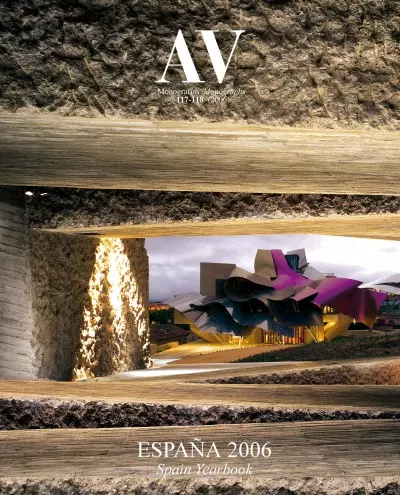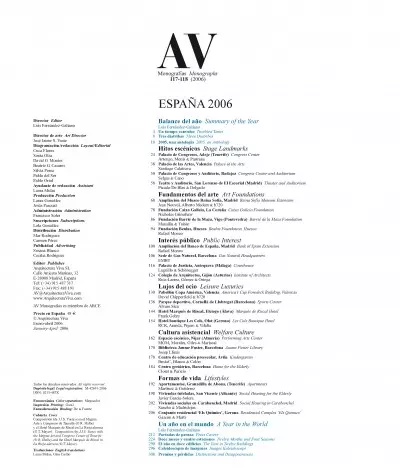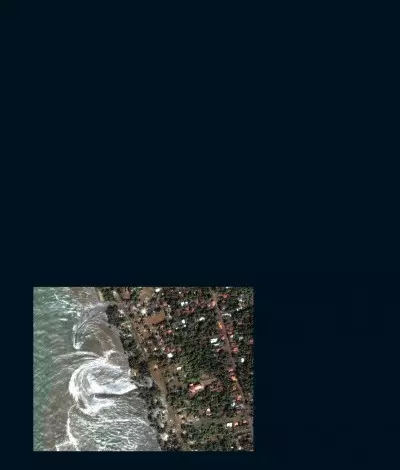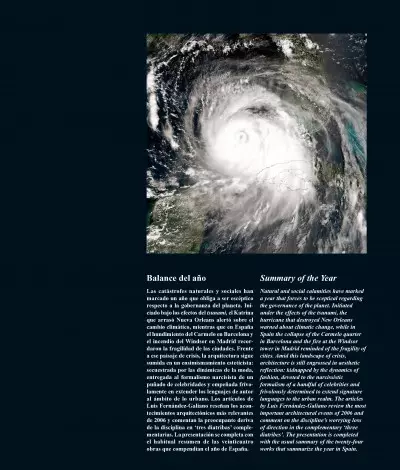ESPAÑA 2006
Balance del año Summary of the Year
Luis Fernández-Galiano
Un tiempo convulso
Troubled Times
Luis Fernández-Galiano
Un tiempo convulso Troubled Times
Tres diatribas Three Diatribes
2005, una antología 2005, an Anthology
Hitos escénicos Stage Landmarks
Palacio de Congresos, Adeje (Tenerife) Congress Center
Artengo, Menis & Pastrana
Palacio de las Artes, Valencia Palace of the Arts
Santiago Calatrava
Palacio de Congresos y Auditorio, Badajoz Congress Center and Auditorium
Selgas & Cano
Teatro y Auditorio, San Lorenzo de El Escorial (Madrid) Theater and Auditorium
Picado-De Blas & Delgado
Fundamentos del arte Art Foundations
Ampliación del Museo Reina Sofía, Madrid Reina Sofía Museum Extension
Jean Nouvel, Alberto Medem & b720
Fundación Caixa Galicia, La Coruña Caixa Galicia Foundation
Nicholas Grimshaw
Fundación Barrié de la Maza, Vigo (Pontevedra) Barrié de la Maza Foundation
Mansilla & Tuñón
Fundación Beulas, Huesca Beulas Foundation, Huesca
Rafael Moneo
Interés público Public Space
Ampliación del Banco de España, Madrid Bank of Spain Extension
Rafael Moneo
Sede de Gas Natural, Barcelona Gas Natural Headquarters
EMBT
Palacio de Justicia, Antequera (Málaga) Courthouse
Laguillo & Schönegger
Colegio de Arquitectos, Gijón (Asturias) Institute of Architects
Ruiz-Larrea, Gómez & Ortega
Lujos del ocio Leisure Luxuries
Pabellón Copa América, Valencia America’s Cup Foredeck Building, Valencia
David Chipperfield & b720
Parque deportivo, Cornellá de Llobregat (Barcelona) Sports Center
Álvaro Siza
Hotel Marqués de Riscal, Elciego (Álava) Marqués de Riscal Hotel
Frank Gehry
Hotel boutique Les Cols, Olot (Gerona) Les Cols Boutique Hotel
RCR, Aranda, Pigem & Vilalta
Cultura asistencial Welfare Culture
Espacio escénico, Níjar (Almería) Performing Arts Center
MGM, Morales, Giles & Mariscal
Biblioteca Jaume Fuster, Barcelona Jaume Fuster Library
Josep Llinás
Centro de educación preescolar, Ávila Kindergarten
BmásC, Blanco & Colón
Centro geriátrico, Barcelona Home for the Elderly
Clotet & Paricio
Formas de vida Lifestyles
Apartamentos, Granadilla de Abona, (Tenerife) Apartments
Martínez & Gutiérrez
Viviendas tuteladas, San Vicente (Alicante) Social Housing for the Elderly
Javier García-Solera
Viviendas sociales en Carabanchel, Madrid Social Housing in Carabanchel
Sancho & Madridejos
Conjunto residencial ‘Els Quimics’, Gerona Residential Complex ‘Els Quimics’
Gascón & Martí
Un año en el mundo A Year in the World
Luis Fernández-Galiano
Portadas de prensa Press Covers
Doce meses y cuatro estaciones Twelve Months and Four Seasons
El año en doce edificios The Year in Twelve Buildings
Caleidoscopio de imágenes Images Kaleidoscope
Premios y pérdidas Distinctions and Disappearances
Luis Fernández-Galiano
Troubled Times
This has been a year of natural catastrophes and social cataclysms. From the echoes of the tsunami of the Indian Ocean to the Kashmir earthquake or the Caribbean hurricane which devastated New Orleans, the violence of the elements made us discuss climate change. In Spain, the fire that destroyed the Windsor building in Madrid and the collapse of the Carmelo neighborhood in Barcelona stressed the fragility of our cities. In the social and political field, the never-ending tragedy of the near East (with the bloody conflict of Iraq, the instability of Iran or Lebanon, and the uncertainty of both Israel and Palestine without Sharon or Arafat) resonates with the anarchy of the American superpower, embarked on an aimless journey of military aggression and clandestine prisons, and the impotence of a Europe that, after rejecting its Constitution and entering a leadership crisis that only seems to have spared the newly arrived Merkel, has been shaken by Islamic terrorism in London, the wrath of the youth in the decaying urban peripheries of France and the desperation of the illegal immigrants in the Spanish cities of northern Africa.
Apart from that, architecture followed its own path, increasingly spectacular and self-absorbed, using the great exhibition and sports events as fuel for urban renovation. Hence the importance of the vie to host the 2012 Olympic Games, that Madrid – under transformation with the ‘big dig’ of its ringroad – did not win, falling behind the victorious London and a stubborn Paris, but before two imperial metropolis, the martyr New York of 9-11 and the Moscow of Putin; all of this while Valencia prepares the America’s Cup of 2007 and Zaragoza the Expo of 2008, which have sparked numerous competitions and projects. In the world, the year witnessed the celebration of the Universal Exposition of Aichi, where the London-based architects Zaera & Moussavi built a fine Spanish pavilion with ceramic hexagons, and the triennial congress of the UIA, which awarded its medal to the Japanese Tadao Ando in a ceremony held in Istanbul.
In a year marked by the live broadcast of the death of the Pope John Paul II, architecture had to mourn the disappearance of many masters, though almost all of them had stepped off the stage a long time ago: Philip Johnson, the great arbiter of the New York scene; Ralph Erskine, the British-Scandinavian pioneer of ecology and participation; Kenzo Tange, who used technique to build the symbols of post-war Japan; Giancarlo de Carlo, the engagé humanist Italian who was the last survivor of Team X; Fernando Távora, master of Siza and founder of Portuguese modernity; James Ingo Freed, the partner of I.M. Pei who designed the Holocaust Memorial Museum in Washington; or Constant, the Dutch sculptor author of the New Babylon. Besides the Spaniards, from Francisco de Asís Cabrero, author of the Trade Union building, who built fascist and rational architecture, to the Sevillian Manuel Trillo, the Alicante architect Juan Guardiola or Madrid’s Javier Feduchi, member of a distinguished saga of architects and furniture designers.
The same can be said of the drizzle of prizes, which celebrated careers or noteworthy buildings without opening different paths to that of the exaltation of the author and the oeuvre. So, the Pritzker went to an enragé, sexagenarian California architect, Thom Mayne, and the Japanese Imperiale was rightly bestowed on the author of the MoMA remodeling, Yoshio Taniguchi; both the British and the American gold medals distinguished architecture with an engineering flavor, the first going to Frei Otto and the second to Santiago Calatrava; Rem Koolhaas won the Mies award for the Dutch Embassy in Berlin, and the late Enric Miralles received, for the Scottish Parliament – completed by his widow Benedetta Tagliabue –, both the British Stirling Prize and that of the Spanish Biennial; lastly, the National Award of Spain went to Guillermo Vázquez Consuegra for the redesign of Vigo’s seafront, while the FAD, an award that now covers the whole peninsula, to Eduardo Souto de Moura for the muscular concrete shapes of Braga’s stadium.
The Art Review published its annual list of the one hundred most influential people in the art world, and on this occasion the list included four architecture firms: the Swiss Herzog & de Meuron, who after inaugurating the pneumatic Allianz Arena in Munich have opened two museums in the United States, the Walker Art Center in Minneapolis and the New De Young Museum in San Francisco; the Genoan Renzo Piano who, aside from completing the Zentrum Paul Klee in Bern, has finished the extension of Atlanta’s High Museum of Art; the aforementioned Koolhaas, who has opened a Prada Store in Los Angeles and a colossal Casa da Música in Porto; and the Anglo-Iraqi Zaha Hadid, who has completed works in Wolfsburg and Leipzig. Much praised buildings that join the Holocaust memorial by Peter Eisenman in Berlin, the pavilion by Frank Gehry in Chicago’s Millennium Park, the Fira of Milan by Massimiliano Fuksas, and the works by Jean Nouvel in Madrid and Barcelona, to compose a still life of excellence or fatigue that also includes some significant completions in the peninsula or the islands, from the Palace of the Arts by Calatrava in Valencia to the Congress Center by AMP in Tenerife.
The chapter of anniversaries and events was reiterative and duly foreseeable. The year of Einstein was also that of the four hundred years of the Quixote, spurring a fuss of hyperbolic celebrations, with no other architectural fruits than a tribute to La Mancha’s most universal architect, Miguel Fisac; the centennials of Albert Speer and Juan O’Gorman, two architects of extraordinary and antithetical political dimension, went more unnoticed than that of Las Vegas, which is quite revealing about the ideological temperature of the times; and also meaningful is the scarce commemorative effort sparked by the 50th anniversary of Hiroshima, a historic abyss that shuns compassion and forgiveness. It has been a year of memory and amnesia, drowsy and convulse, tragic as much for the calamities experienced as for the sensation of loss of direction in the governance of this vulnerable planet.








